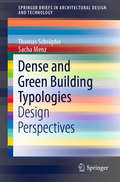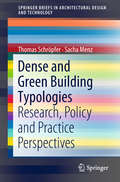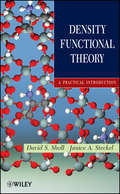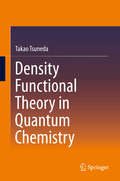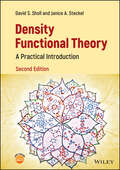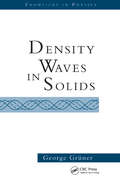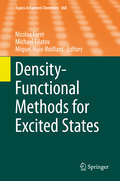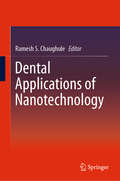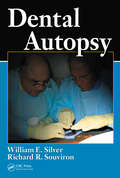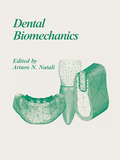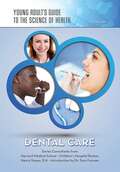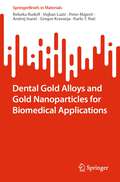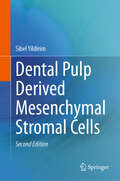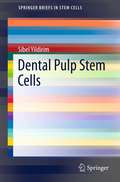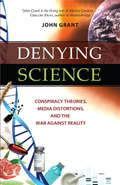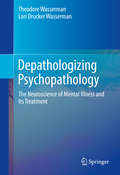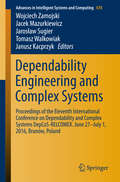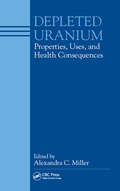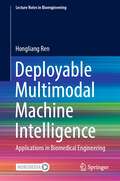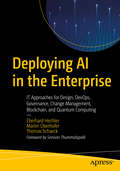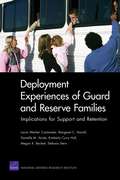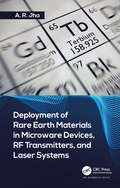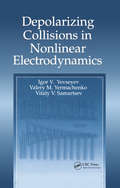- Table View
- List View
Dense and Green Building Typologies: Design Perspectives (SpringerBriefs in Architectural Design and Technology)
by Thomas Schröpfer Sacha MenzIn this book, leading architects and landscape architects provide their perspectives on the design of dense and green building types in high-density urban contexts that can support higher population densities, higher standards of environmental sustainability and enhanced liveability in future cities.
Dense and Green Building Typologies: Research, Policy and Practice Perspectives (SpringerBriefs in Architectural Design and Technology)
by Thomas Schröpfer Sacha MenzIn this book, academics, policy makers, developers, architects and landscape architects provide a systematic review of the environmental, social, economic and design benefits of dense and green building types in high-density urban contexts and discuss how these can support higher population densities, higher standards of environmental sustainability and enhanced live ability in future cities.
Density Functional Theory
by Janice A Steckel David ShollDemonstrates how anyone in math, science, and engineering can master DFT calculationsDensity functional theory (DFT) is one of the most frequently used computational tools for studying and predicting the properties of isolated molecules, bulk solids, and material interfaces, including surfaces. Although the theoretical underpinnings of DFT are quite complicated, this book demonstrates that the basic concepts underlying the calculations are simple enough to be understood by anyone with a background in chemistry, physics, engineering, or mathematics. The authors show how the widespread availability of powerful DFT codes makes it possible for students and researchers to apply this important computational technique to a broad range of fundamental and applied problems.Density Functional Theory: A Practical Introduction offers a concise, easy-to-follow introduction to the key concepts and practical applications of DFT, focusing on plane-wave DFT. The authors have many years of experience introducing DFT to students from a variety of backgrounds. The book therefore offers several features that have proven to be helpful in enabling students to master the subject, including:Problem sets in each chapter that give readers the opportunity to test their knowledge by performing their own calculationsWorked examples that demonstrate how DFT calculations are used to solve real-world problemsFurther readings listed in each chapter enabling readers to investigate specific topics in greater depthThis text is written at a level suitable for individuals from a variety of scientific, mathematical, and engineering backgrounds. No previous experience working with DFT calculations is needed.
Density Functional Theory in Quantum Chemistry
by Takao TsunedaIn this book, density functional theory (DFT) is introduced within the overall context of quantum chemistry. DFT has become the most frequently used theory in quantum chemistry calculations. However, thus far, there has been no book on the fundamentals of DFT that uses the terminology and methodology of quantum chemistry, which is familiar to many chemists, including experimentalists. This book first reviews the basic concepts and historical background of quantum chemistry and then explains those of DFT, showing how the latter fits into the bigger picture. Recent interesting topics of DFT in chemistry are also targeted. In particular, the physical meanings of state-of-the-art exchange-correlation functionals and their corrections are described in detail. Owing to its unconventionality, this book is certain to be of great interest not only to chemists but also to solid state physicists.
Density Functional Theory: A Practical Introduction
by David S. Sholl Janice A. SteckelDensity Functional Theory A concise and rigorous introduction to the applications of DFT calculations In the newly revised second edition of Density Functional Theory: A Practical Introduction, the authors deliver a concise and easy-to-follow introduction to the key concepts and practical applications of density functional theory (DFT) with an emphasis on plane-wave DFT. The authors draw on decades of experience in the field, offering students from a variety of backgrounds a balanced approach between accessibility and rigor, creating a text that is highly digestible in its entirety. This new edition: Discusses in more detail the accuracy of DFT calculations and the choice of functionals Adds an overview of the wide range of available DFT codes Contains more examples on the use of DFT for high throughput materials calculations Puts more emphasis on computing phase diagrams and on open ensemble methods widely used in electrochemistry Is significantly extended to cover calculation beyond standard DFT, e.g., dispersion-corrected DFT, DFT+U, time-dependent DFT Perfect for graduate students and postdoctoral candidates in physics and engineering, Density Functional Theory: A Practical Introduction will also earn a place in the libraries of researchers and practitioners in chemistry, materials science, and mechanical engineering.
Density Functionals
by Erin R. JohnsonThe series Topics in Current Chemistry presents critical reviews of the present and future trends in modern chemical research. The scope of coverage is all areas of chemical science including the interfaces with related disciplines such as biology, medicine and materials science. The goal of each thematic volume is to give the non-specialist reader, whether in academia or industry, a comprehensive insight into an area where new research is emerging which is of interest to a larger scientific audience. Each review within the volume critically surveys one aspect of that topic and places it within the context of the volume as a whole. The most significant developments of the last 5 to 10 years are presented using selected examples to illustrate the principles discussed. The coverage is not intended to be an exhaustive summary of the field or include large quantities of data, but should rather be conceptual, concentrating on the methodological thinking that will allow the non-specialist reader to understand the information presented. Contributions also offer an outlook on potential future developments in the field.
Density Waves In Solids
by George Gruner?Density Waves in Solids is written for graduate students and scientists interested in solid-state sciences. It discusses the theoretical and experimental state of affairs of two novel types of broken symmetry ground states of metals, charge, and spin density waves. These states arise as the consequence of electron-phonon and electron-electron interactions in low-dimensional metals.Some fundamental aspects of the one-dimensional electron gas, and of the materials with anisotropic properties, are discussed first. This is followed by the mean field theory of the phases transitions?discussed using second quantized formalism?together with the various experimental observations on the transition and on the ground states. Fluctuation effects and the collective excitations are reviewed next, using the Ginzburg-Landau formalism, followed by the review of the interaction of these states with the underlying lattice and with impurities. The final chapters are devoted to the response of the ground states to external perturbations.
Density-Functional Methods for Excited States
by Nicolas Ferré Michael Filatov Miquel Huix-RotllantThe series Topics in Current Chemistry presents critical reviews of the present and future trends in modern chemical research. The scope of coverage is all areas of chemical science including the interfaces with related disciplines such as biology, medicine and materials science. The goal of each thematic volume is to give the non-specialist reader, whether in academia or industry, a comprehensive insight into an area where new research is emerging which is of interest to a larger scientific audience. Each review within the volume critically surveys one aspect of that topic and places it within the context of the volume as a whole. The most significant developments of the last 5 to 10 years are presented using selected examples to illustrate the principles discussed. The coverage is not intended to be an exhaustive summary of the field or include large quantities of data, but should rather be conceptual, concentrating on the methodological thinking that will allow the non-specialist reader to understand the information presented. Contributions also offer an outlook on potential future developments in the field. Review articles for the individual volumes are invited by the volume editors. Readership: research chemists at universities or in industry, graduate students
Dental Applications of Nanotechnology
by Ramesh S. ChaughuleThis book discusses current trends and potential areas of nanotechnology applications in dental materials. Dentistry is undergoing yet another change to benefit mankind via the discipline of nanodentistry. A variety of nanostructures such as nanorobots, nanospheres, nanofibers, nanorods, etc., have been studied for various applications in dentistry and medicine. Preventive dentistry has also utilized nanodentistry to develop the nanomaterials for inclusion in a variety of oral health-care products. Methods to prevent and combat dental problems have been devised, discussed, and implemented since ancient times; however, there is a constant need for improved tools and techniques. This book is relevant academically for undergraduate and post-graduate dental students, dental practitioners, researchers, and faculties of dental universities, as this book explores the application of various nanobiomaterials in dentistry, discusses current research in dental nanomaterials and potential future areas of interest, and examines the use of nanotechnology in various fields of dentistry.
Dental Autopsy
by William E. Silver Richard R. SouvironThe most advanced and complete forensic dentistry resource of its kind, this volume provides essential guidance in all areas of forensics odontologly. It supplies medical examiners and forensic investigators with the detailed information needed to perform their work with the highest level of authority in the dental autopsy lab, the field, and the c
Dental Biomechanics
by Arturo N NataliDental Biomechanics provides a comprehensive, timely, and wide-reaching survey of the relevant aspects of biomechanical investigation within the dental field. Leading the reader through the mechanical analysis of dental problems in dental implants, orthodontics, and natural tooth mechanics, this book covers an increasingly important and popular sub
Dental Care: A Teen's Guide To Dental Care (Young Adult's Guide to the Science of He #15)
by Autumn LibalDid you know that poor dental hygiene can increase your risk of heart attack and stroke? Or that the incidence of cavities and tooth decay increases in the teenage years? Did you know that countries with a higher standard of living (like the United States, Canada, and England) actually have higher rates of tooth loss and decay than countries with a lower standard of living? Or that dental drills existed for thousands of years before people even had electricity? Dental hygiene is extremely important to both your physical and emotional health. Your teeth are an integral part of many important activities, such as eating, speaking, and smiling. From the Mayan practice of inlaying semi-precious stones into teeth to today's practices of braces and high-tech dental care, this book covers a wide range of dental topics. It will tell you how dental care has developed throughout the ages and will introduce you to some of today's most cutting-edge technologies. Most important, it will guide you through everything you need to know about caring for your teeth and maintaining a beautiful smile today and into the future.
Dental Gold Alloys and Gold Nanoparticles for Biomedical Applications (SpringerBriefs in Materials)
by Rebeka Rudolf Vojkan Lazić Peter Majerič Andrej Ivanič Gregor Kravanja Karlo T. RaićThis book focuses on recent advances in dental gold alloys and gold nanoparticles (GNPs) for biomedical applications. Dental gold alloys combine several highly desirable mechanical properties, such as high strength, ductility, and elasticity, with an extremely robust chemical stability in the mouth. Moreover, astonishing progress has been made in the use of GNPs as novel gold biomaterials that provide a multifunctional platform for cellular imaging, biosensing, and targeted drug delivery in tumour immunotherapy and photothermal therapy. Beginning with a comprehensive overview of the development and use of dental gold alloys, the book addresses the materials properties that are crucial for dental applications, focusing on aspects such as microstructure, chemical and mechanical stability, ageing, biocompatibility, and colour retention. The book then shifts focus to the use of GNPs in dental applications, delving into different techniques of GNP synthesis for specifically tailoring the size, shape, and stability of GNPs in biological media. In addition to these factors, it addresses how their exposure route, surface chemistry, as well as how the steric effects of their coating impact biodistribution and determine the level of GNP toxicity in the human body. Featuring topical literature reviews alongside up-to-date published experimental results, this book offers an attractive resource for practicing scientists and engineers working in the field of gold-based biomaterials.
Dental Pulp Derived Mesenchymal Stromal Cells
by Sibel YildirimThis book presents an evaluation of stem cells from human dental pulp as a reliable stem cell source for cell-based therapy to stimulate tissue regeneration. In this thoroughly updated and expanded second edition, the author covers mesenchymal stem cell (MSC) biology, various sources of MSCs, and the therapeutic potential of MSCs. Tooth regeneration, dental pulp-derived MSC, and the therapeutic potential of dental pulp derived stem cells is also covered. This is an essential resource for students, faculty, and researchers in academia and industry working on dental pulp stem cells.
Dental Pulp Stem Cells
by Sibel YildirimStem cell technology is moving forward at a tremendous rate. Recent discoveries have surprised even the most expert researchers. While every piece of new data broadens the current knowledge and contributes to this moving forward, the new data also serve as paradigm shifters of fundamental knowledge of cell biology. While the question 'What is a Stem Cell' may now seem to basic to even discuss, there are still some discrepancies, however, between groups in terms of their functional roles. Teeth develop from the ectoderm of the first branchial arch and the ectomesenchyme of the neural crest. Deciduous teeth start to form between the sixth and eighth weeks, and permanent teeth begin to form in the twentieth weeks. Several studies have demonstrated that the pulp from both adult teeth and deciduous teeth contains dental pulp stem cells. Several factors have made them very attractive as a model system for many researchers; they are multipotent, ethically and non-controversially available in large numbers, immuno-compatible, developmentally primitive, easy to isolate and have high expansion potential in vitro. However, many controversies still exist in the field. There are several unanswered questions in the biology of dental pulp and odontoblasts. This new volume in the SpringerBriefs in Stem Cells series presents an evaluation of stem cells from human dental pulp as a reliable stem cell source for cell-based therapy to stimulate tissue regeneration.
Dental Radiography: Principles and Techniques
by Joen Iannucci Laura Jansen HowertonSet yourself up for success with this must-have oral radiography text. Dental Radiography: Principles and Techniques gives you a comprehensive foundation for the safe, effective use of radiation in the modern dental office. This combination textbook and training manual features easy-to-understand content combined with step-by-step techniques and a stellar art program to help you apply what you’ve learned to practice. Plus, new content focuses on pediatrics and the latest in digital and three-dimensional technology!
Denying Science
by John GrantIs global warming just scaremongering by climatologists conspiring to protect their jobs? Is evolution "just a theory"? Is autism caused by vaccinations? The answer to all of these questions is, of course, no. The scientific evidence is now in, and it's conclusive, on these and many more issues that are fundamental to our knowledge and wellbeing. But you'd never know this if all of your information came from the popular media or your upbringing and immediate circle of influence didn't include critical thinking and basic scientific literacy. As this witty book with a very serious message shows, our culture has in recent decades been characterized by a widespread antagonism toward science and the not-always-welcome messages it brings. Large sections of the supposedly sophisticated populations in the developed nations are in an active state of denial. Not only do they deny scientific evidence but they also call into question the very competence of science as a descriptor of reality. In short, they deny reality. The author surveys the gamut of clearly unscientific ideas concerning the food we eat, the medicines and potions we are either afraid of or advised to take, our sex preferences, and a host of other issues that are raised by various panics, urban legends, and a general climate of misinformation. He also examines how special interests, from agribusiness to pharmaceutical companies to creationists, actively work to distort or suppress scientific findings. While the tendency may be to laugh at some of the ridiculous notions catalogued in the author's overview of bogus ideas, the overall picture he creates is anything but funny. This book reminds the reader that the future of free, increasingly complex societies depends on an educated citizenry that is able to think clearly and critically based on reliable information.
Depathologizing Psychopathology
by Theodore Wasserman Lori Drucker Drucker WassermanThis brief, accessible treatise harnesses the neurophysiological processes of learning to create an innovative and powerful approach to therapy. It sets out a non-pathologizing alternative not only to the current medicalized conception of diagnosis and treatment but also to the labeling of relatively normal reactions to stressors and upsets as illnesses. Rooted in the neurobiology of human learning, the book's approach to treatment, Neuro-Cognitive Learning Therapy, characterizes maladaptive behavior patterns as learned responses to upsetting conditions--processes which can be unlearned. In addition, the coverage includes a clinical teaching guide for bringing NCLT theoryand methods into the training curriculum. This groundbreaking volume: Proposes a non-stigmatizinglearning model for therapy, Neuro-Cognitive Learning Therapy. Introduces the concept of the connectome and explains its criticalrole in mental health and illness. Differentiates between theunconscious and automaticity in cognition and behavior. Addresses theapplicability of NCLT to biologically-based mental disorders. Offers case studies illustrating NCLT in contrast with commonly-used approaches. Includes a chapter-by-chapter clinical teaching guide with therapeutic principles and discussion questions. Provides a comprehensivetherapeutic framework for practitioners of all orientations. Depathologizing Psychopathology gives neuropsychologists, psychiatrists, clinical social workers, and child and school psychologists new ways of thinking about mental illness and learning about learning for a bold new step in the evolution of mind/brain knowledge.
Dependability Engineering and Complex Systems
by Janusz Kacprzyk Wojciech Zamojski Jacek Mazurkiewicz Jarosław Sugier Tomasz WalkowiakThese proceedings present the results of the Eleventh International Conference on Dependability and Complex Systems DepCoS-RELCOMEX which took place in a picturesque Brunów Palace in Poland from 27th June to 1st July, 2016. DepCoS-RELCOMEX is a series of international conferences organized annually by Department of Computer Engineering of WrocÅ,aw University of Science and Technology since 2006. The roots of the series go as far back as to the seventies of the previous century - the first RELCOMEX conference took place in 1977 - and now its main aim is to promote a multi-disciplinary approach to dependability problems in theory and engineering practice of complex systems. Complex systems, nowadays most often computer-based and distributed, are built upon a variety of technical, information, software and human resources. The challenges in their design, analysis and maintenance not only originate from the involved technical and organizational structures but also from the complexity of the information processes that must be efficiently executed in a diverse, often hostile operational environment. Traditional methods of reliability evaluation focused only on technical resources are usually insufficient in this context and more innovative, multidisciplinary methods of dependability analysis must be applied. The diversity of the topics which need to be considered is well illustrated by the selection of the submissions in these proceedings with their subjects ranging from mathematical models and design methodologies through software engineering and data security issues up to practical problems in technical, e. g. transportation, systems.
Depleted Uranium: Properties, Uses, and Health Consequences
by C. Miller AlexandraA compilation of published scientific information, including human, animal, cellular, and theoretical studies, Depleted Uranium: Properties, Uses and Health Consequences provides the most current and comprehensive collection of information on depleted uranium health hazards. The editor and her international panel of contributors are clinical and ba
Deployable Multimodal Machine Intelligence: Applications in Biomedical Engineering (Lecture Notes in Bioengineering)
by Hongliang RenThis book highlights the principles, design and characterization of mechanically compliant soft and foldable robots. Traditional rigid robots with bulky footprints and complicated components prolong the design iteration and optimization for keyhole and minimally invasive transluminal applications. Therefore, there is an interest in developing soft and foldable robots with remote actuation, multimodal sensing and machine intelligence. This book discusses the use of foldable and cuttable structures to design biomimetic deployable soft robots, that can exhibit a fair number of motions with consistency and repeatability. It presents the overall design principles, methodology, instrumentation, metamorphic sensing, multi-modal perception, and machine intelligence for creating untethered foldable active structures. These robotic structures can generate a variety of motions such as wave induction, compression, inchworm, peristalsis, flipping, tumbling, walking, swimming, flexion/extension etc. Remote actuation can control motions along regular and irregular surfaces from proximal sides. For self-deployable medical robots, motion diversity and shape reconfiguration are crucial factors. Deployable robots, with the use of malleable and resilient smart actuators, hold this crucial advantage over their conventional rigid robot counterparts. Such flexible structures capable of being compressed and expanded with intelligence perceptions hold enormous potential in biomedical applications.
Deploying AI in the Enterprise: IT Approaches for Design, DevOps, Governance, Change Management, Blockchain, and Quantum Computing
by Eberhard Hechler Martin Oberhofer Thomas SchaeckYour company has committed to AI. Congratulations, now what? This practical book offers a holistic plan for implementing AI from the perspective of IT and IT operations in the enterprise. You will learn about AI’s capabilities, potential, limitations, and challenges. This book teaches you about the role of AI in the context of well-established areas, such as design thinking and DevOps, governance and change management, blockchain, and quantum computing, and discusses the convergence of AI in these key areas of the enterprise.Deploying AI in the Enterprise provides guidance and methods to effectively deploy and operationalize sustainable AI solutions. You will learn about deployment challenges, such as AI operationalization issues and roadblocks when it comes to turning insight into actionable predictions. You also will learn how to recognize the key components of AI information architecture, and its role in enabling successful and sustainable AI deployments. And you will come away with an understanding of how to effectively leverage AI to augment usage of core information in Master Data Management (MDM) solutions.What You Will LearnUnderstand the most important AI concepts, including machine learning and deep learningFollow best practices and methods to successfully deploy and operationalize AI solutionsIdentify critical components of AI information architecture and the importance of having a planIntegrate AI into existing initiatives within an organizationRecognize current limitations of AI, and how this could impact your businessBuild awareness about important and timely AI researchAdjust your mindset to consider AI from a holistic standpointGet acquainted with AI opportunities that exist in various industriesWho This Book Is ForIT pros, data scientists, and architects who need to address deployment and operational challenges related to AI and need a comprehensive overview on how AI impacts other business critical areas. It is not an introduction, but is for the reader who is looking for examples on how to leverage data to derive actionable insight and predictions, and needs to understand and factor in the current risks and limitations of AI and what it means in an industry-relevant context.
Deployment Experiences of Guard and Reserve Families: Implications for Support and Retention
by Margaret C. Harrell Danielle M. Varda Megan K. Beckett Laura Werber Kimberly Curry HallUse of the Reserve Component has steadily increased since the 1990s, but little research has focused on how deployment affects guard and reserve families. This monograph presents the results of interviews with reserve component personnel and spouses, focusing on their deployment experiences and military career intentions. The authors conclude with suggestions on how the Department of Defense can better support guard and reserve families.
Deployment of Rare Earth Materials in Microware Devices, RF Transmitters, and Laser Systems
by Ph. D. A. R. JhaDeployment of Rare Earth Materials in Microware Devices, RF Transmitters, and Laser Systems describes the deployment of rare earth materials that offer significant improvement in the RF performance, reliability, weight, and size of microwave devices, RF transmitters, and laser systems. RF components, microware transmitters, laser systems, and special timing devices are described, with an emphasis on improvement in the performance parameters.
Depolarizing Collisions in Nonlinear Electrodynamics
by Igor V. Yevseyev Valery M. Yermachenko Vitaly V. SamartsevIn this book, the authors derive the theory of elastic depolarizing collisions and describe their importance in some nonlinear electromagnetic phenomena in gaseous media. The formation of photon echo and a description of its various types in gaseous media are then presented. The authors show that the characteristics of the corresponding signals depend essentially on elastic depolarizing collisions. They also consider the advantages of a new kind of photon echo spectroscopy: polarization photon echo-spectroscopy. A high-level, specialized treatment, Depolarizing Collisions in Nonlinear Electrodynamics will appeal to researchers and advanced graduates in nonlinear optics and quantum electronics.
